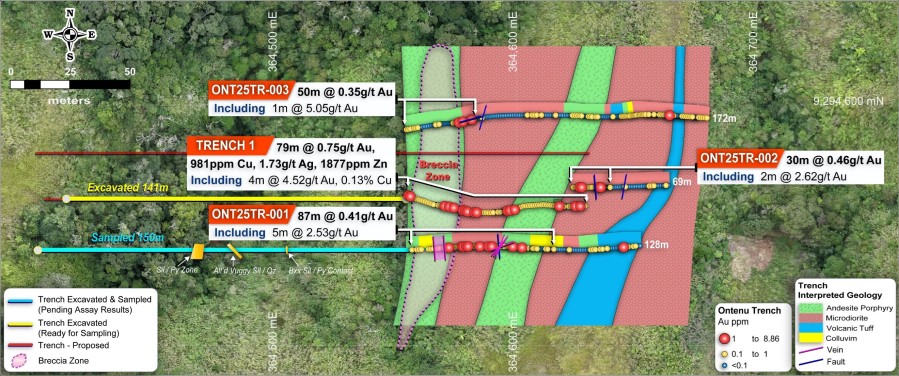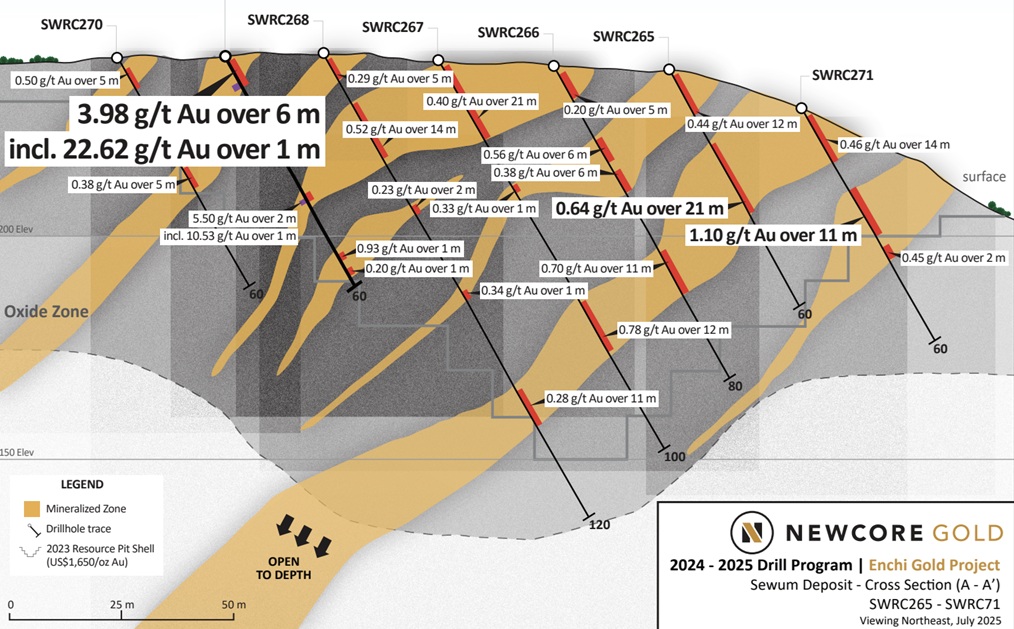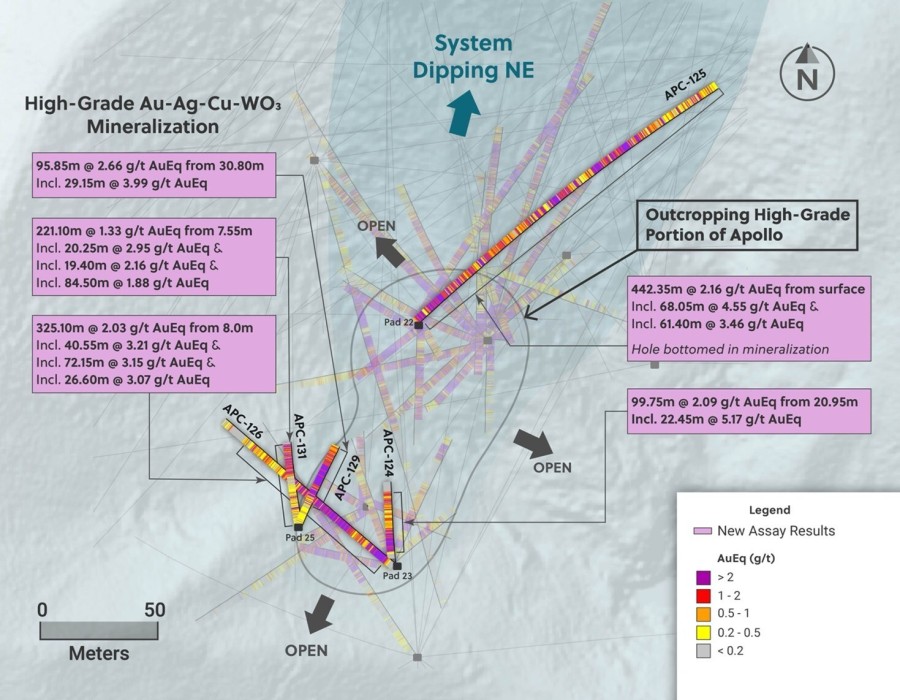VANCOUVER, Nov. 29, 2017 /CNW/ - Rye Patch Gold Corp. (TSX.V: RPM; OTCQX: RPMGF; FWB: 5TN) (the "Company" or "Rye Patch") reports results of scout drilling of the sulfide zone at the Company's flagship Florida Canyon mine in Nevada.
Highlights of sulfide scout drillholes:
- Drillhole FCR-17-016 contained two gold zones including 70.1 metres grading 2.94 grams per tonne (g/t) gold and 56.4 metres grading 2.60 g/t gold;
- FCR-17-015 contained three gold zones including 35.1 metres grading 2.08 g/t gold, 57.9 metres grading 1.30 g/t gold, and 15.2 grading 1.08 g/t gold.
William Howald, Rye Patch President and CEO said, "We are extremely pleased with the results of this scout drilling program. Based on the drill results and our exploration model, management believes the sulfide blanket beneath Florida Canyon could host a substantive high-grade ore body beneath the oxide zone. By quantifying the sulfide mineralization, Florida Canyon has the initial makings of a world-class ore body located in Nevada."
The reverse circulation (RC) drill program was designed to test the distribution of the sulfide body and validated the current geologic model and ore controls. The three gold zones identified in drill hole FCR-17-015 consist of 35.1 metres grading 2.08 g/t gold starting at 88.4 metres, 57.9 metres grading 1.30 g/t gold starting 129.5 metres, and 15.2 grading 1.08 g/t gold starting at 236.2 metres, all using a 1.0 g/t gold cut off.
The drillhole was located in an untested sulfide area between the Central and Main pits. The intersections confirm the notion that the mineralization has a similar structural geometry to the oxide zone thus connecting the two zones. The multiple intercepts demonstrate a substantial thickness and breadth of the sulfide zone.
Using a 1.0 g/t gold cut off, FCR-17-016 identified two gold zones including 70.1 metres grading 2.94 g/t gold starting at 79.2 metres and 56.4 metres grading 2.60 g/t gold starting at 164.6 metres. The drillhole was located along the northern portion of the sulfide body where existing assay information suggested lower grade in the sulfide zone. The drillhole shows the historic data will need more off-set and twin drillholes to confirm grade distribution and tenor. The results are well above the predicted grade and thickness of the northern sulfide area and are a promising surprise.
A follow-up core program is warranted and will use the new information to better target and quantify the down dip and lateral extensions of the sulfide body.
Previous owner of the Florida Canyon mine, Pegasus Gold, completed an internal report titled "Sulfide Project Pre-feasibility Study" dated July 18, 1996 on the sulfide mineralization at Florida Canyon. A total of 262 drillholes (241 RC and 21 core) touched or penetrated the sulfide body and yielded an average grade of 2.36 g/t gold in the sulfide zone with gold values as high as 100 g/t Au (2.93 opt Au) in a northeast oriented structural zone. Pegasus completed a resource estimate within a Whittle pit design at US$400 gold price, and a series of metallurgical tests including floatation, pressure oxidation, roasting, and bio-oxidation.
The metallurgical test work showed an overall recovery of 90 percent by flotation with 94 percent of the gold reporting to a sulfide concentrate. Additional metallurgical test work will be done by Rye Patch on material from the drill program. A Qualified Person has not done sufficient work to classify this historical information as a current mineral resource or mineral reserve and the Company is not treating this historical information as a current mineral resource or mineral reserve.
Drilling in the Central area has expanded the oxide resource. Drillholes FCR-17-001 to FCR-17-014 and FCR-17-017 and FCR-17-018 were drilled in the Central pit area where the block model showed waste material but mining is encountering gold above cut-off grade. The drillholes were successful in changing the waste designation to ore and expanding the oxide resource, and the area is currently being mined.
All drillhole sampling was conducted under the supervision of the Company's project geologists, and a strict chain of custody from the project to the sample preparation facility was implemented and monitored. The RC samples were delivered to American Assay Laboratory's preparation facility in Reno, Nevada, where they were crushed and pulverized. The pulverized material was digested and analyzed for gold using fire assay fusion and an atomic absorption spectroscopy finish on a 30-gram assay split. All other elements were determined by inductively coupled plasma analysis. Data verification of the assay and analytical results are completed to ensure accurate and verifiable results. A blank, duplicate or a certified standard was inserted approximately every 10th sample.
IDS Directional Drilling and Borehole Surveying of Elko, Nevada completed gyroscopic downhole surveys on all drillholes. The Florida Canyon mine survey team completed final collar locations using differential GPS.
William Howald, AIPG Certified Professional Geologist #11041, Rye Patch Gold's CEO and President with a BSc. in Geological Engineering, is a Qualified Person as defined under National Instrument 43-101. He has reviewed and approved the contents of this news release.
About Rye Patch Gold Corp.
Rye Patch Gold Corp. is a Nevada based, Tier 1, mining company engaged in the mining and development of quality resource-based gold and silver mines and projects along the established Oreana trend in west central Nevada. Leveraging its strong financial position and cash to acquire the operating Florida Canyon Gold Mine, Rye Patch Gold Corp. now controls a trend‑scale platform with mining operations, resource projects and exploration upside.
The combination of operations and organic growth along a major Nevada gold trend positions Rye Patch as an emerging mid-tier gold producer with tremendous value‑added potential. For more information, please visit our website at www.ryepatchgold.com.





